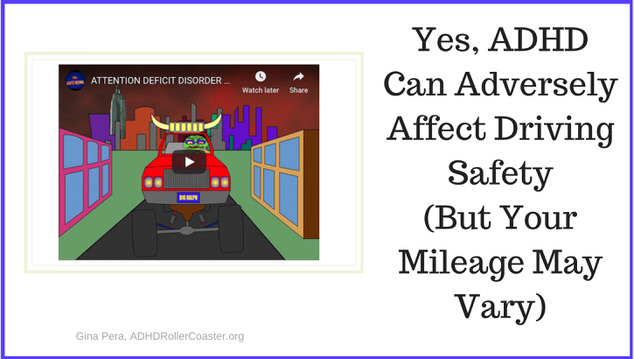ADHD And Driving: Research-Based Strategies For Safer Journeys

Table of Contents
Understanding the ADHD-Driving Connection
ADHD, or Attention-Deficit/Hyperactivity Disorder, is characterized by inattention, hyperactivity, and impulsivity. These symptoms significantly impact various aspects of driving, creating challenges that require proactive management. The inattentive aspects of ADHD can lead to difficulty focusing on traffic conditions, while hyperactivity and impulsivity can manifest as erratic driving behaviors.
Specific driving behaviors often affected by ADHD include:
- Difficulty maintaining attention on the road: Individuals with ADHD may experience mind-wandering, easily getting distracted by sights or sounds outside the vehicle, leading to lapses in attention crucial for safe driving.
- Impulsive lane changes or sudden braking: Impulsivity can result in unsafe lane changes without proper signaling or sudden braking without sufficient warning, endangering other drivers.
- Problems with speed regulation and maintaining safe following distances: Difficulties with impulse control and sustained attention can lead to speeding, tailgating, and unsafe following distances.
- Increased risk of distracted driving due to hyperactivity: The hyperactive nature of ADHD can contribute to increased fidgeting, restlessness, and a higher propensity for engaging in distracting behaviors while driving. This could include adjusting the radio frequently, reaching for objects, or engaging in conversations.
Research-Based Strategies for Safer Driving with ADHD
Successfully managing the challenges of ADHD and driving requires a multi-faceted approach combining medication, therapy, environmental modifications, and strong support systems.
Medication Management
Medication plays a significant role in improving focus and impulse control, crucial for safer driving. Stimulant and non-stimulant medications are commonly prescribed to manage ADHD symptoms.
- Consistent medication adherence: Taking medication as prescribed by a doctor is paramount for consistent symptom management and improved driving performance. Missed doses can significantly impact focus and impulse control.
- Managing potential side effects: Some medications may cause side effects such as decreased appetite, difficulty sleeping, or increased heart rate. Open communication with your doctor is essential to address and manage these side effects effectively.
- Open communication with your doctor: Regularly discussing the effectiveness of medication on driving performance with your healthcare provider is crucial for adjusting treatment as needed.
Behavioral Therapies and Driving Skills Training
Cognitive Behavioral Therapy (CBT) and specialized driving rehabilitation programs can provide valuable tools for managing driving challenges related to ADHD.
- CBT techniques: CBT helps individuals identify and modify negative thought patterns and behaviors that contribute to impulsive or inattentive driving. Techniques like mindfulness and self-monitoring can be particularly beneficial.
- Professional driving assessments and tailored training programs: These programs provide personalized evaluations of driving skills and offer tailored training to address specific areas of weakness.
- Practicing safe driving habits in controlled environments: Simulated driving environments allow for practicing safe driving techniques in a risk-free setting, building confidence and improving skills before navigating real-world traffic conditions.
Environmental Modifications and Driving Strategies
Modifying driving habits and the environment can significantly reduce risks associated with ADHD and driving.
- Avoid driving during peak fatigue times: Driving when tired can exacerbate ADHD symptoms and impair judgment. Avoid driving early in the morning or late at night when fatigue is most likely.
- Adjust routes to minimize distractions and traffic congestion: Choosing less congested routes reduces the likelihood of encountering stressful driving situations that can overwhelm individuals with ADHD.
- Utilize technology: GPS navigation systems can minimize distractions associated with finding directions, while phone mounts ensure safe and convenient mobile phone usage.
- Drive with a skilled passenger: Having a supportive passenger who can help with navigation, monitor driving behavior, or provide encouragement can significantly improve safety.
The Importance of Disclosure and Support Systems
Open communication about your ADHD diagnosis is crucial. Informing your insurance company about your ADHD can sometimes result in tailored support or programs designed to improve driving safety. Furthermore, a strong support network plays a vital role in safe driving.
- Open communication with loved ones: Discussing your driving challenges with family and friends fosters understanding and allows for shared responsibility in ensuring safe driving practices.
- Seeking professional support: Therapists specializing in ADHD and driving rehabilitation specialists can provide valuable guidance and support.
- Creating a supportive environment: A supportive environment that encourages open communication and proactive strategies significantly improves the chances of safe and responsible driving.
Driving Safely with ADHD: A Path Forward
Successfully managing ADHD and driving requires a proactive approach encompassing medication management, behavioral therapies, environmental modifications, and a strong support system. By consistently implementing these strategies and engaging in open communication with healthcare professionals, individuals with ADHD can significantly improve their driving safety. Remember to consult with your healthcare provider to develop a personalized plan for managing ADHD and driving safely. For more resources and support, consider exploring organizations like CHADD (Children and Adults with Attention-Deficit/Hyperactivity Disorder). Taking proactive steps to address ADHD and driving concerns is crucial for the safety of everyone on the road.

Featured Posts
-
 Analyzing You Tubes Growth Among Older Demographics An Npr Perspective
Apr 29, 2025
Analyzing You Tubes Growth Among Older Demographics An Npr Perspective
Apr 29, 2025 -
 Papal Conclave Legal Battle Over Convicted Cardinals Voting Eligibility
Apr 29, 2025
Papal Conclave Legal Battle Over Convicted Cardinals Voting Eligibility
Apr 29, 2025 -
 160km Mlb
Apr 29, 2025
160km Mlb
Apr 29, 2025 -
 Nine African Countries Affected By Pw Cs Departure
Apr 29, 2025
Nine African Countries Affected By Pw Cs Departure
Apr 29, 2025 -
 The Fight Within The Gop Trumps Tax Plan In Jeopardy
Apr 29, 2025
The Fight Within The Gop Trumps Tax Plan In Jeopardy
Apr 29, 2025
Latest Posts
-
 Our Yorkshire Farm Amanda Owens Emotional Farewell
Apr 30, 2025
Our Yorkshire Farm Amanda Owens Emotional Farewell
Apr 30, 2025 -
 The Challenges Of Growing Up On Our Yorkshire Farm Reuben Owens Perspective
Apr 30, 2025
The Challenges Of Growing Up On Our Yorkshire Farm Reuben Owens Perspective
Apr 30, 2025 -
 Our Yorkshire Farm Reuben Owen Opens Up About His Childhood Struggles
Apr 30, 2025
Our Yorkshire Farm Reuben Owen Opens Up About His Childhood Struggles
Apr 30, 2025 -
 Our Yorkshire Farm Channel 4 Announcement Sparks Further Complaints Against Amanda Owen
Apr 30, 2025
Our Yorkshire Farm Channel 4 Announcement Sparks Further Complaints Against Amanda Owen
Apr 30, 2025 -
 Amanda Owen Raising 9 Children On Our Farm Next Door
Apr 30, 2025
Amanda Owen Raising 9 Children On Our Farm Next Door
Apr 30, 2025
